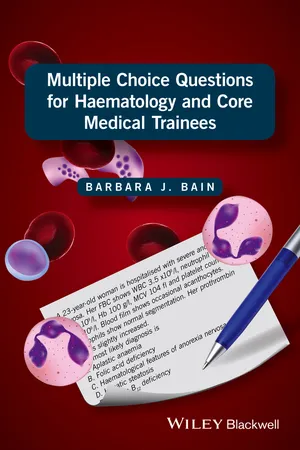
- English
- ePUB (mobile friendly)
- Available on iOS & Android
Multiple Choice Questions for Haematology and Core Medical Trainees
About this book
Written to help haematology and general medical trainees evaluate their own knowledge, and particularly useful for those preparing for the Part 1 examination of the Royal College of Pathologists. This exam-centered book will also be of use to core medical trainees preparing for the examinations of the Royal College of Physicians and the Royal Australasian College of Physicians and to haematology and general medicine trainees in other countries where methods of examination are similar.
The 150 questions are presented in two formats, Single Best Answer and Extended Matching Question, and comes complete with detailed feedback and, when appropriate, relevant references are given for each question so that those who select the wrong answer will understand why another answer is better.
- Quick reference question book, ideal for examination preparation
- Includes 50 SBA questions, ideal for the Part 1 and Part 2 MRCP examinations, which although having a general medical slant, are also appropriate for haematology specialist trainees
- Includes 70SBA multiple choice questions appropriate for haematology specialist trainees but also useful to core medical trainees
- Includes 30EMQs suitable for those taking Part 1 of the FRCPath examination
- Questions come complete with fully referenced answers and discussion points
This book provides an educational tool for training as well as an ideal way to prepare for examinations and is also of value to those who examine in haematology and haematopathology.
Frequently asked questions
- Essential is ideal for learners and professionals who enjoy exploring a wide range of subjects. Access the Essential Library with 800,000+ trusted titles and best-sellers across business, personal growth, and the humanities. Includes unlimited reading time and Standard Read Aloud voice.
- Complete: Perfect for advanced learners and researchers needing full, unrestricted access. Unlock 1.4M+ books across hundreds of subjects, including academic and specialized titles. The Complete Plan also includes advanced features like Premium Read Aloud and Research Assistant.
Please note we cannot support devices running on iOS 13 and Android 7 or earlier. Learn more about using the app.
Information
Section 1
Single Best Answers Questions 1–50
MRCP part 1 level
SBA 1
- Adult T-cell leukaemia/lymphoma
- Chronic lymphocytic leukaemia
- Follicular lymphoma in leukaemic phase
- Mantle cell lymphoma
- Reactive lymphocytosis
SBA 2
- BK virus
- Herpes simplex
- JC virus
- Treponema pallidum
- Varicella-zoster virus
SBA 3
- 60 g/l
- 70 g/l
- 80 g/l
- 90 g/l
- 100 g/l
SBA 4
- Aplastic anaemia
- Folic acid deficiency
- Haematological features of anorexia nervosa
- Hepatic steatosis
- Vitamin B12 deficiency
SBA 5
- α thalassaemia trait
- Anaemia of chronic disease
- Anaemia of chronic disease plus iron deficiency
- β thalassaemia trait
- Iron deficiency
SBA 6
- Lead poisoning
- Myelodysplastic syndrome (refractory anaemia)
- Myelodysplastic syndrome (refractory anaemia with ring side...
Table of contents
- Cover
- Title Page
- Copyright
- Preface
- Normal Ranges and Abbreviations
- Section 1: Single Best Answers Questions 1–50
- Section 2: Single Best Answers Questions 51–120
- Section 3: Extended Matching Questions 1–30
- Section 4: Single Best Answers Answers to Questions 1–120 with Feedback
- Section 5: Extended Matching Questions Answers and Feedback
- Index
- End User License Agreement